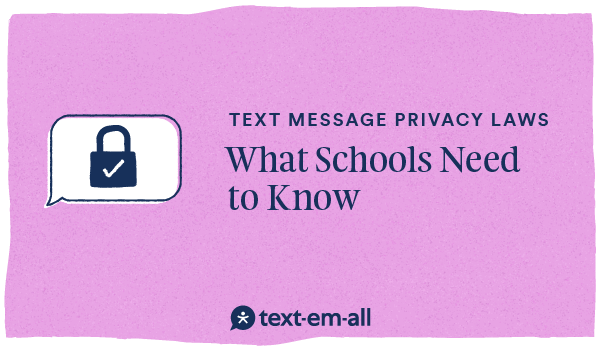
Mass messaging and SMS conversations can be an effective tool for nearly every school, college and university. The medium allows educational institutions to communicate with current students and can even help with outreach, allowing schools to get in touch with prospective students in a personal way.
At this point you might be wondering, "Why would I bother with texting when I could just email?" After all, you probably already have a contact list of emails for current students, and you could seem like an easier, more effective option. That's where we come in. With a mass text messaging service, texting can be just as easy as emailing, but with a better return. Statistics show that email-open rates are staggeringly low, averaging around 20%. In contrast, surveys have revealed that 97% of people open every text message they receive, 9 out of 10 texts are read in 3 minutes or less, and 45% of texts receive replies. Studies have also show that most millennials prefer information in the form of text messaging.
After studying the data, it's not difficult to see why texting is the future for education institutions. That being said, it's important for schools to put in the work to familiarize themselves with the text message privacy laws and consumer protection regulations, which can vary state-to-state.
Managing Student Privacy Laws
Although institutions may already feel as though they have a good handle on student privacy when it comes to emails and phone calls, texting is a completely different ballgame. But, by understanding which compliance regulations need to be met, and then closely following the rules and regulations that apply, it's simple to use mass text messaging safely and effectively. Learn how a mass texting service is the most effective way to keep people informed when it matters most.
FERPA and TCPA Laws
The two main regulations to keep in mind when it comes to privacy and texting are the Family Educational Rights and Privacy Act (FERPA) and the Telephone Consumer Protection Act (TCPA).
The FERPA act simply states that a student's information should be kept private. In other words, only those who have a legitimate need to see the student’s data should be able to. FERPA regulations do not apply to prospective students.
TCPA laws are much broader. They are not specific to education and apply to everyone, whether they're current students, parents, alumni, or even prospective students. It's also a best practice to keep all regulations currently in place for a phone call and email communications and apply them to all texting communications as well.
When Should Schools Text Students?
Although the open rate for text messaging is close to 100%, this only applies when the messages are not spam. If students receive dozens of texts from their school that they're just not interested in, they'll start to ignore the messages in the same way that they ignore spam phone calls and emails.
Even if it's legal to text a student, each text needs to be timely, relevant, and offer some kind of value. For example, current and prospective students will want to receive informational texts including reminders about deadlines, updates from their admission counselors, and new information from their advisors.
Obtaining Written Consent
The TCPA requires schools to have consent from their recipients, regardless of whether they're students, parents, faculty or staff. This means that before considering texting as an appropriate form of communication, schools need to get their written consent. There are a few different ways to get this.
An easy way to acquire this consent is to ask contacts to enter their phone number in an online or in-person form. Ask for their consent during that process.
Another way to gain consent is through text message opt-in. If taking the opt-in route, schools should include a call-to-action telling recipients they must subscribe to the SMS service. For example, "Respond YES to subscribe to our school notification service." During this opt-in process, schools should tell contacts the purpose of the service and how often they should be expecting to receive texts. The message and data rates that could apply should also be presented, along with the terms of service. Schools should document text message opt-in by capturing and recording it.
The Option to Opt-Out
After receiving consent from all the constituents, make sure to send them a text showing how they can opt-out or unsubscribe from your SMS messages. The directions as to how they can opt-out should be simple, clear, and concise. It could be something as simple as: “Reply with STOP to unsubscribe from our text messaging service." When you send your first message through Text-Em-All, we'll automatically include this message for you.
What Policies Should Schools Have in Place?
Even though teacher/student communication is pretty common these days, it's important that academic staff and back-end employees abide by the right rules, including the FERPA act and the Open Record laws. Only text students if it is absolutely necessary. In addition, make sure contacts know who is receiving and responding to the text messages. This should be the case regardless of the device or network. This should help curb any attempt to communicate irrelevant information by either students or faculty.
Archiving text messages will keep students' information safe, and help keep schools compliant. While there are many ways to archive text messages, choose a compliant method. The method should capture and record the texts in real-time and then store them securely. Securing messages that contain students' information is absolutely vital. This will guarantee they are fully protected from any potential hackers or data breaches that the organization may be exposed to.
One of the most important things to do when schools start to message students is to include the name of the institution, organization, or company in the first message. This is one area where the FCC rules do apply, even for non-profit organizations. The fine ranges from $500 to $1,500 for each violation, so it's imperative to remember to inform contacts.
Schools should also not initiate any kind of text communication between students or their families between the hours of 9 p.m. and 8 a.m. Use the time zone of the recipient in this regard, and not your own. This rule does not apply to responding to a text that has been sent by a student.
While it may seem like there are a lot of rules and regulations, don’t let worries regarding violations stop you from using text as a way to communicate with your current or future students. The National Association for College Admission Counseling, or NACAC for short, has stated that colleges that are not-for-profit, along with universities, should not concern themselves with this law. However, the NACAC still recommends reading up on the laws so schools can make sure they are following them as closely as possible.
Student Privacy and FERPA
While safeguards are in place through the TCPA, schools can give their students another layer of protection through the FERPA act. We touched on this earlier, but let's dive a little deeper. The FERPA act is enforced by the U.S. Department of Education, who is primarily responsible for federal assistance to educational institutions. Since FERPA is enforced by the U.S. Department of Education, regulations apply to all K-12 schools, as well as any higher education facility that obtains federal funding. FERPA focuses more on information that can identify a person on a personal level.
For example, sharing a deadline for a tuition payment is not personally identifiable in terms of information. However, the amount a student owes on their tuition, the money they've paid in the past, and even dates of previous payments would be protected by FERPA.
FERPA regulations are especially important when looking at SMS texts because students' educational records need to be sent through a FERPA-compliant system. When dealing with sensitive information or data transfer, as schools often do, it's vital to remain compliant at all times.
Security Measures and Student Data
Like many forms of communication, texting cannot be completely secure. Texting is susceptible to something called "spoofing," which is when a sender makes it look like their message is coming from a trusted source. Some SMS providers provide spoofing protection, but if yours does not, it's something to consider looking into for the safety of the students.
To properly understand student privacy, establish a very common understanding as to what data you have and the differences between each data set. Student data is collected information that is used within an educational context. While it's been used in school for quite some time, the introduction of online learning and an increase in technology makes it more difficult to keep the data completely secure.
Some of the data that schools may collect from their students include:
- Their name, gender, age, race, socioeconomic status, ethnicity and other demographic data schools may request when registering a student at the start of the year.
- Test scores, health records, disciplinary records, and attendance. This helps schools to see how a student is progressing throughout their education.
- Observational data about their behavior and interests that educators perceive throughout the school day. This could include student performance information, such as homework and learning application outcomes.
Texting and Student Privacy Compliance
Privacy is somewhat of an amorphous concept, and it can be defined in many ways. Today, technology such as smartphones and trackers can make it feel as though privacy no longer exists. Institutions, such as governments and big corporations, often harvest and retain huge sets of information about users, which is sometimes collected without knowledge or consent.
Educational privacy is completely different. Student privacy often refers to the equitable collection of data. Any storage of this data involves both long- and short-term risks, and students are not often equipped to understand or weigh out the potential benefits or risks that come with data collection. Due to the nature of this, having these privacy measures in place and meeting all of the required regulations is absolutely vital.
It's essential to not treat privacy as an item to be checked off a list, or something to pursue only to be legally compliant. Privacy is integral when it comes to the effective use of data, and it also helps support students in both an ethical and equitable manner. School districts should remember that although student data can be immensely valuable for teaching and data analyzation, it comes with a decent amount of risk that could personally affect students' lives. When proper privacy protections are not put into place, schools and districts can face both a legal and ethical risk.
Transparent Policies
Transparent policies and solid texting software is necessary to make sure that students' data is protected. Even if schools do not expect to be transferring or storing sensitive information about their students through text, they still have to make sure the right policies are in place. This will give students, students' parents, and faculty peace of mind because they will know the school is using a good communication that won't exploit their data. A best practice to ensure students' privacy is protected is to use the messaging system primarily to inform and update students about currently events.
Conclusion
SMS messaging is easily the best, most simple way to stay in touch with students, parents, faculty and staff. Since text messages have such a high open rate, it's the best way to communicate deadlines and other time-sensitive issues.
Using Text-Em-All as your texting provider is the best way to ensure compliance, fast text delivery and most of all, student satisfaction.












